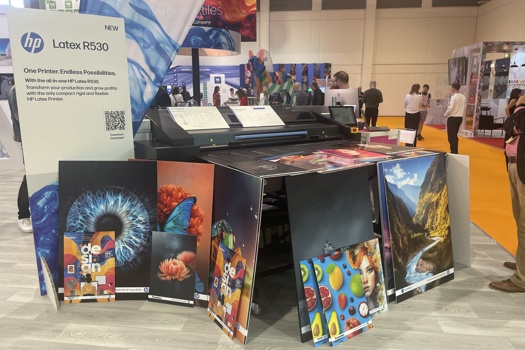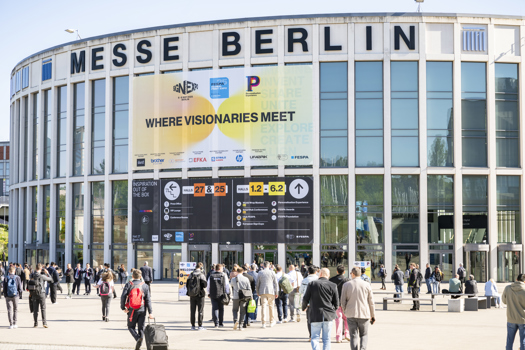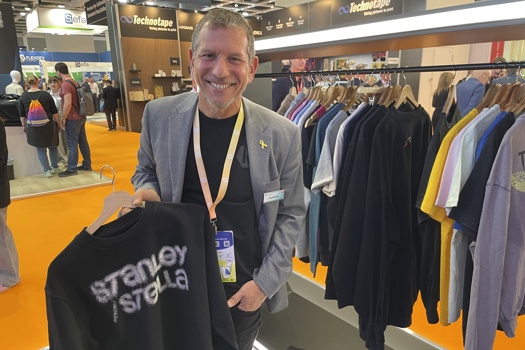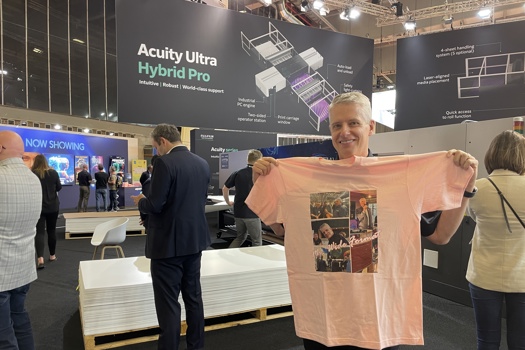
The greenfield gravure superplant started up in 2006, and has now gone live with its first web offset press as part of a £5m-plus investment that includes a huge solar panel installation. It’s all part of a strategy that puts sustainability at the front and centre of operations, as managing director Richard Gray explains.
Jo Francis We meet at a very interesting time for the printing sector in general – there’s so much going on, not all of it good. What’s your view?
Richard Gray I think, my general view is that last year we saw ongoing decline in the demand for paper and printed products. It’s pretty clear that that is in part people choosing to do other things with their time – and that’s a long-term decline that you can probably track back to pre-1990. That was masked through the 1990s and probably up until 2008 by a fairly buoyant advertising market that was pushing pagination and allowing the printing sector to be successful. And what you can see really post-broadband and the smartphone is that people’s time is now being taken up online doing other things.
Games, videos, music, chat…
That’s led to an ongoing decline in demand. At the same time, the advertising eyeballs have been migrating from paper and publications to online. You can see if you look at the advertising spend, there is an ongoing boom in digital advertising. Year on year advertising spend is going up, but it’s reducing in print paper. TV growth, radio pretty flat. But the internet keeps growing at 6%-7% a year.
I remember a while back you said something about the emperor’s new clothes and hoping to be able to debunk some of the exaggeration surrounding the effectiveness of internet advertising.
There are people who are better placed to say that than me. I think there are voices within some of the big FMCGs where they are questioning whether or not they get the return on investment and value for money from the click-throughs and internet advertising. Equally, if you look at the general measure of advertising spend increasing, which is pretty well all going into digital, versus GDP growth, you have to say that businesses will not be able to keep spending at increasing rates above the GDP rate because they’re not getting the return. At some point in time, there will be a rationalisation. Whether or not that means that print will become more popular again, none of us know. Maybe it will arrest the decline.
Maybe more print will be employed in combination with digital media?
Yes, maybe in combination – things that work together. The interesting thing we have to do collectively, as the printing industry, is recognise that this is not a problem that is unique to the printing industry. If you’re a high street retailer, you are struggling with similar issues. Structural change in how people buy, insurgent digital businesses... We’re not unique.
That’s true. It could be worse, we could be retailers.
We’re often as an industry a bit ‘woe is us’. It’s just a challenging modern business. We live in a market that’s changing very fast. My sense of the overall print market is that last year we really saw the paper companies change how they approach the market. They can make money out of pulp and packaging, and when there’s a world shortage of pulp it’s no surprise they cut their least profitable lines. Probably in a position now where we see the weaker printing businesses not able to sustain their capital assets. The volumes aren’t there, the prices aren’t there and they’re inefficient so it’s not sustainable. Ultimately we as a business have a challenge of sustainability. Sustainability in lots of ways. Are our businesses sustainable? Can we keep working? Can we maintain the customer base we’ve got? Also, as a business are we doing the least possible damage to the environment?
That’s a big agenda item.
It is a big agenda. And it’s a massive, massive issue. Interestingly, that leads us to why we ended up buying a 16pp web offset press.
Really?
Our strategy can be summed up as how we can be sustainable. On the way in you walked past an 11MW combined heat and power plant. Why do we run a CHP? Because it’s 30%-40% more efficient in terms of its CO2 impact. Because we’re generating power and heat and chilled water all at the same time, from the same energy. So since this site was conceived back in 2004 the environment has been a big consideration.
It’s incredibly impressive.
The thing that you didn’t see when you walked in is that on the roof we have literally just commissioned 1.1MW of photovoltaic panels. It’s 4,000 panels.
Wow! Solar power? In Liverpool?
Yes, believe it or not, even in the south of Liverpool! That energy generation capability provides in order of around 12% of our power requirements, with zero CO2.
That’s brilliant. I often think that pretty much every printer who’s able to should be doing do this with their roof space.
Along with the work we’ve done on efficiencies, and probably the two projects LED lighting and the solar generation, it will power pretty well 85% of the power requirement of the M600. Our peak hour requirement here is somewhere between seven and eight megawatts, of which we will generate five and a half using the CHP probably around about point eight megawatts will come from photovoltaics. And the rest will come from the grid. So we’re looking at quite a sustainable level of energy.
Stupid question, but if the CHP can do 11MW, why not run it at 11?
Because it would actually be inefficient. And it makes sense in terms of our steam demand and our chilled water demand.
Onto the new press. How long has the M600 been up and running?
Let me start with why we bought it: the answer to me is sustainability again. Because we see the press being there to do three things. One is to print covers and therefore print the covers in-house that we used to have to subcontract. And, you know, why is that more sustainable? Really for two reasons. One is, we were starting to become concerned about the downstream suppliers.
Yes, you mentioned this at the time, with the various company failures including of course G&H.
Indeed. And secondly, because we want to reduce the CO2 miles of the end product. Intermediate transport is costly and clearly involves unnecessary transport CO2 into the environment. The second thing we want to print on the press is inserts. We handle somewhere in the region of 1.4bn to 1.6bn inserts and onserts a year for publishing clients. Many are not printed near our site here in Liverpool, so we wanted the ability to offer the production of two to 16pp products, which we can’t do with our gravure presses as it’s too small.
So of all the many, many formats you can produce using gravure, you can’t do those?
Well we can do a 16pp, but not two pages, and we couldn’t do 4pp. The vast majority of inserts and onserts are in that 2pp-16pp range. We very much wanted to offer our clients and potential new clients the ability to run inserts and onserts on site here. The sustainability point, again, is there’s no CO2 miles in terms of the transport. And there is the ability to run a later deadline. Again, some reason and logic in it. And in a world where we have to compete with the internet, where you have pricing and advertising that can change almost instantaneously, a month’s lead time on the content for an insert is just too long for many of our retailers. So we really want to be able to offer a shorter lead time and later data, and a more sustainable end product.
In terms of the volume of inserts that clients would be likely to require, does that still work with the M600?
Yes, when you get down to 2pp, 4pp and 8pp, bigger presses are too big. They’re producing too many per cylinder revolution and it’s not efficient.
For example then, if one of your big weekend newspaper supplement clients wanted something at short notice, that sort of quantity of inserts is do-able?
In a small pagination, yes.
Have you done any of that yet?
We’re already doing backing cards. We’ve already produced quite a lot of covers, a few inserts, mailers, quite a lot of different products. And then the third reason we bought the press was customisation and personalisation...
…with those fancy Kodak inkjet heads
We wanted to be able to provide mailing solutions to our clients. It shortens lead times into mailing. And it reduces the CO2 impact of intermediate transport. And to some extent, we see there will be a little bit of a trend towards naked mailing, to removing the polythene wrap. Along with the press, which is able to do full colour personalisation we are in the process of installing inkjet heads onto some of our finishing equipment – onto the stitchers – so we can do naked mailing and produce the finished product.
That’s interesting.
It’s clever. And it takes a step out of production, removes intermediate transport and it reduces lead times. And we can do the downstream access straight from here.
I don’t think of you doing mailing things.
We have employed Tony Cowlishaw the former sales director of Sunline.
Ah-ha. That sounds like a good move. A while back we also spoke about paper wrapping, how’s that progressing?
We are in the process of researching and progressing with a paper-wrap alternative to polythene film. Watch this space.
When did the new web start up?
The press started running mid-March with our first production run. Since then we have added the UV varnishing unit and pre-folder so that allows us to do 6pp-8pp gatefold covers and UV varnishing, so the press is actually quite flexible.
It is quite a swish item. Who’s running it, I recall you were going to take some of the former G&H people on.
We took seven or eight people from G&H so that’s made the installation and commissioning much more straightforward because they are people who’ve run the press before. I think we’re fortunate that within our strategy, that whole sort of sustainability strategy outlined at the start of last year, that a 16pp web press was something that we were interested in doing. I think it’s fair to say because of the G&H insolvency we moved faster than we otherwise would have.
Events, dear boy events, as the saying goes.
Yes, and obviously a used machine is less capital requirement than a new machine. And, because we’re part of a bigger print group, some people have asked us, ‘what are you doing? You’re a gravure printer, you’re buying web offset you can’t do that!’. Bullshit, of course we can.
Yeah, what on earth were you thinking?
We have a very small web offset plant in Gutersloh, which I think is the biggest web offset site in Europe! I think the other thing that is helpful, we are part of a big, financially secure profitable print group that is managed with that sustainability and knowledge. We do things professionally.
Compare and contrast recent events elsewhere on the continent, with BPG’s planned shutdown of Nuremberg…
Of course, it’s sad to be shutting down a big plant, but demand in the market means that plant is no longer sustainable. As Bertelsmann we do the right thing. It will be a managed shutdown and we will honour all the working agreements we have. Of course, we’d rather not be shutting a plant, but the reality of the market is, there’s overcapacity.
Remind me, how did you come from Trinity Mirror to here?
I was approached. By Stephan Krauss [who was then chief executive of the Arvato printing business that is now part of the Bertelsmann Printing Group].
Ah, I remember meeting him.
I had 19, 20 happy years in newspaper printing.
You were a management trainee at Mirror Colour Print, is that right?
The HR director of the time was Kathy Woodward. The late, great Kathy Woodward. And she was a visionary in this industry. They were in the process of moving their printing capacity out of Fleet Street into new plants around the country and they chose to take on some people from a slightly different background than maybe would have been normal for the newspaper business.
Some bright graduates with a fresh outlook.
So I joined as part of that in 1988. I joined what was BNPC, then became MCP, then Trinity Mirror Printing now Reach Printing.
And having been headhunted by Hr Krauss, you were the second boss at this plant, you replaced that American chap.
Yes. Bob Robinson was first. It always pays to be second. If anyone asks advice, on a big project, be second.
Spot on!
That said, I have done some reasonably big projects with builds and re-investments.
And you’ve been here ever since. Nearly 12 years has gone very fast.
I’ve been here ever since and it’s been fun. We’ve gone through what I would consider to be the same changes and challenges that any part of the UK and European printing business has. We’ve seen declining demand. We’ve seen our customers demanding and needing lower prices. We’ve had to deal with massive consolidation, and what I would consider to be some maverick competitors.
Yes, just a bit…
And we now have a more settled marketplace, but still distressed. We need not to be too woe is me. Every manufacturing business has challenges. Every publishing business has challenges. All of our clients have challenges, and the internet and digitisation has disrupted almost everything.
I often think about this because we always look at the decline, in terms of things like circulation, but if you were starting with a blank sheet of paper this is a huge business.
Yes, we’re still a big industry. It’s a lot less paper than it was, but it’s still a big industry and if managed carefully it has a sustainable future. But one thing we can guarantee is that if we keep doing what we do today we won’t be sustainable. We have to continue to think about how we can find sustainable opportunities.
What’s it like being the last Iceman?
What?
I mean you’re the last Iceman in publication gravure in the UK.
We’re not a gravure printer, we’re a printer first and we happen to use the gravure process as our primary route for putting ink on paper and actually, it works very well for a lot of clients where we are able to offer slightly smaller formats and save paper. We’re able to produce great quality on sometimes not great, expensive, papers. And there’s no doubt if we’re looking at long run jobs from our perspective it is still by far the best way to get consistent results across a very long production run. That said the market is shrinking so there are less and less long-run jobs and there are less and less very high-pagination catalogues.
Which was your bread and butter.
It was our bread and butter and I think we should be realistic to believe that we need to combine that with an ability to produce smaller volumes. So lower paginations lower run lengths. More customisation and more versions. For that reason, we’ve taken the step into offset world. Which is just another way of putting ink on paper.
Talking of paper, is declining gravure volumes an issue in terms of paper supply? I see some paper manufacturers have pulled out of that market.
Demand for paper is changing. The big paper companies are changing how they supply that marketplace and have closed or refocused. One of the things we’re seeing is hybrid paper that can be used for gravure or web offset. That can present something of a challenge to both printing methods in getting the best reproduction for clients. Again, we have an advantage in being part of a big group. We also have a paper and ink lab in Dresden providing a service to the whole group that does a lot of work on developing substrates and how we engrave and use inks to get the best result.
What are run lengths like now?
It varies. We won an order recently that is five million copies. There are still some significant long runs out there. In the newspaper supplement world, the Daily Mail’s Weekend magazine is 2m copies every week. It is a significant chunk of work. For News UK there are three magazines of 800,000 each for the Sunday Times. For Argos we still print in excess of four million catalogues a year.
Exactly! Whenever I go into an Argos it’s obvious that people still want their catalogues and promo leaflets.
Yes they do. We do have to make the case for print. I’m an admirer of the guys at Two Sides and at Print Power and think they do a pretty good job in terms of making the case. I think we as printers have to do a bit more, we need to really celebrate and be excited about the products we produce and not spend too much time apologising.
I second that.
It’s still a great industry and we still produce great products. We have great staff, who are very highly skilled. And most people would come into a print factory as you have done today, and just think, ‘Wow, how does that work’. We should celebrate what we do, because what we do is great. ‘See this press, it’s printing at 60km an hour – it’s an amazing process’.
Back to run lengths, what’s the lowest run you produce using gravure?
It is a little bit dependent on both pagination and how many copies. Probably around 90,000.
I remember interviewing Stephan Krauss back in 2005 during the build phase and it was something of a sensation when he said it could be as low as 200,000!
It’s finding the balance between cylinder manufacture and makeready time, running time, and ultimately making sure it’s profitable. We’ve done a lot of work with lean production techniques that has enabled us to reduce makeready times. Ultimately it’s an economic question.
When you were showing me around this – hugely impressive by the way – factory it was interesting to hear you compare the gravure presses to web offset formats.
Our 2.75m-wide TR6 is the equivalent to a 96pp long-grain web press, while the three 4.32m-wide TR12s are each equivalent to two 80pp web presses – so we have the equivalent of six 80pp web presses and a 96pp here. People who haven’t been to the site before are blown away by the scale. However, I don’t think we’ll ever see another publication gravure press installed.
Anywhere?
No. We have the last-ever KBA gravure press here. We have to be realistic, the only presses bought new or installed since then have been in Brazil. Some presses have been moved from the close-downs. That doesn’t mean our gravure presses can’t keep going for a long time. The reason we won’t see any more is the overcapacity that exists. Hence what happened at Polestar and what we’re seeing at Circle Media.
We certainly do live in interesting times. What’s typical day like for you Richard, or is there such a thing?
Not really. Every day is different. It’s a business where we have to think every day, how can we improve our levels of productivity, our workforce here are really important – actually sustainability comes from also having an engaged workforce who believe in the business and luckily we do. We have a really good workforce here who are passionate about the business. So my time is spent talking to clients, thinking about how we can develop the business strategically, how we can become more sustainable and that can involve anything from a productivity project to an investment project on the roof, to how we can develop the business and the market. Frankly, for the last couple of months, how we can deal with Brexit.
Yes, I saw your Brexit preparedness statement on your website.
My personal point-of-view is that businesses can cope with an awful lot, but they need to know in advance what pitch they’re going to be playing on and what the rules are. I don’t feel that right now we’re any wiser about that.
I saw that you’d been to some high-flying places – Harvard and Stamford – as part of the Bertelsmann Printing Group management training programme. What was that like?
Being at Harvard was a tremendous opportunity to go through one of the most famous universities and business schools in the world. To have your mind opened to a world of business challenges and a world of opportunities. At Stamford it was about understanding the digitisation challenge, big data and artificial intelligence – and how those things are going to impact our business going forward. It was tremendously interesting. As business leaders we should be aware of what technology can do now and what it can do in the future to enhance the efficiency and sustainability of the business going forward.
Training seems to be a big thing, at all levels?
I’m fortunate that I work for a group that invests a lot in training their people. We spend about £160,000-£180,000 a year on training in the business. From enhancing skills on the shopfloor to management training and ILM [International Leadership & Management] programmes. We really want to make sure our people have the skills to operate effectively in their current roles, and also potentially progress in their careers.
Back to the new web. How have clients reacted?
We’ve had a lot of really positive feedback. Customers are delighted to be talking with a printing company that’s talking positively about the future. The printing market is challenged, but you have to have some belief that it will be around for a long time. It will be different, but it will be around for the long-term.
Final question: what will success look like in a year or two? I see you potentially have space for another one in the web press hall.
Success is a return on investment, it’s as simple as that. We have shareholders and we need to provide ROI. I’m confident that we will make that and then look at the next step for the business. And yes, we do have room for a second web press...










